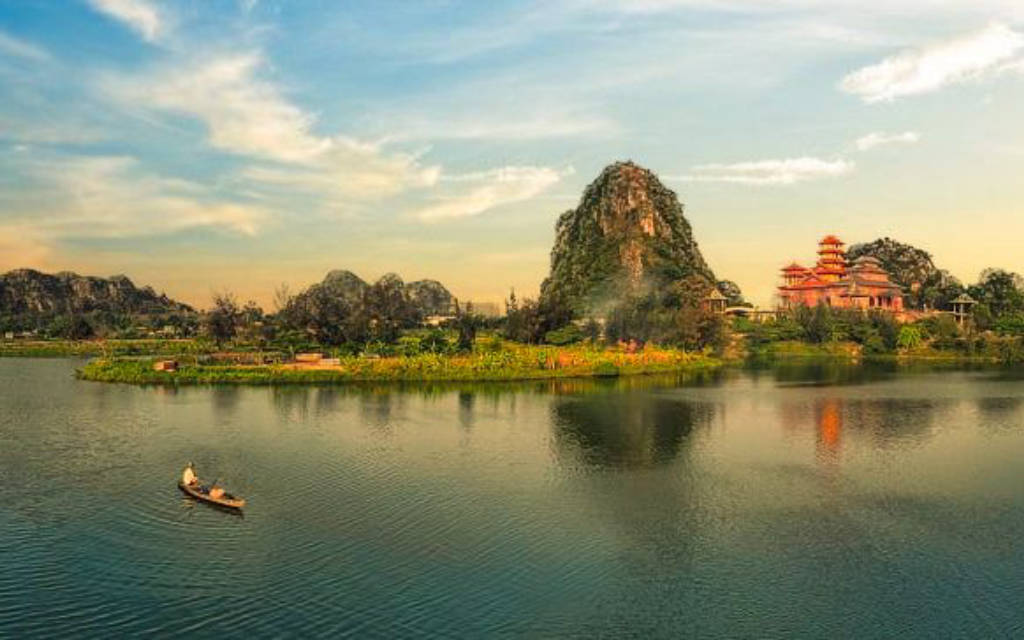Ngu Hanh Son (Marble Mountains), also known as Non Nuoc, is a famous scenic complex in Da Nang, Vietnam. Located about 8 km southeast of the city center, this area includes six limestone mountains: Moc Son, Thuy Son (the largest and most beautiful), Tho Son, Kim Son, and Hoa Son (consisting of Duong Hoa Son and Am Hoa Son), with a total area of approximately 2 km². On March 22, 1990, Ngu Hanh Son was recognized as a National Cultural and Historical Site, affirming its special cultural and historical value, attracting tourists who love history and excursions.
Planning and Conservation
According to the Prime Minister's Decision on July 11, 2023, the scenic area has a total planned area of up to 1,049,701 m². This area not only includes the mountains but also contains many valuable religious and architectural relics, along with green spaces and water bodies.
Name and History
The name ""Non Nuoc"" has long appeared in folklore with two verses:
"In the afternoon, clouds cover Son Tra,
Thunder roars, Non Nuoc, the sky turns to rain."
And was first recorded in Le Quang Dinh's "Hoang Viet Unified Geography and Chronicles" in 1806. By 1825, King Minh Mang visited and officially recognized the names of the mountains in 1837. Besides the name Ngu Hanh Son, the area is also known as Ngu Uan Son and Ngu Chi Son, reflecting the rich culture and history of this scenic spot, where legends and historical stories have lived on in the hearts of the people.
Geographical Features and Ecosystem
Ngu Hanh Son is the result of natural erosion, creating unique caves and shapes, making it an attractive destination for those who love excursions and experiences. The marble here has different colors depending on each mountain, contributing to the beautiful and unique landscape. The rich ecosystem with many types of herbs, forest flowers, and characteristic animals is an ideal place for those who love nature and want to seek moments of relaxation and freedom.
Relics and Culture
Ngu Hanh Son is also famous for many historical relics such as Tam Thai Pagoda, Linh Ung Pagoda, along with cultural imprints of the Cham people. These architectural works not only have spiritual value but also contain many fascinating historical stories. The caves and pagodas here preserve many valuable historical documents from previous dynasties, offering tourists rich cultural experiences, helping to understand more about the civilization of the ancestors.
Information on Each Mountain
- Kim Son: The highest peak with a bell shape, home to the ancient Quan Am Pagoda, attracting Buddhist followers.
- Moc Son: Parallel to Thuy Son, with few trees and an eroded shape, a quiet place for tourists to wander and contemplate.
- Thuy Son: The highest mountain with three peaks and many relics, the most attractive destination for tourists, offering a sense of freedom for those who want to explore culture and history.
- Hoa Son: Consisting of two peaks, Am and Duong, famous for rich legends and historical relics, an ideal destination for those who love exploration.
- Tho Son: The lowest peak, shaped like a dragon, with ancient Cham architectural traces, creating an interesting space for tourists to explore.
Legend of Formation
According to Cham legends, Ngu Hanh Son were formed from the egg of a dragon, hatching into a beautiful girl and becoming five mountains, each corresponding to an element in the Five Elements theory. This legend not only enriches the history but also brings fascinating mysterious stories for tourists.
Stone Sculpture Craft
Ngu Hanh Son is also famous for stone sculpture craft, with over 400 years of history. The Da Nang city government has implemented many policies to protect the relics and support the sustainable development of the stone sculpture craft, creating conditions for artisans to showcase their talents and preserve traditional cultural values.
Ngu Hanh Son is not only a magnificent natural scenic spot but also a cultural and historical symbol of Da Nang. This is truly an unmissable destination for those who love personal travel, seeking peace in the heart of nature and exploring unique cultural values.
 Register
RegisterSign in Travel Agent
Sign in Supplier
Sign in Affiliate
Sign in Guru



 81 Huyền Trân Công Chúa, P. Hoà Hải, Q. Ngũ Hành Sơn, Tp. Đà Nẵng, Việt Nam
81 Huyền Trân Công Chúa, P. Hoà Hải, Q. Ngũ Hành Sơn, Tp. Đà Nẵng, Việt Nam